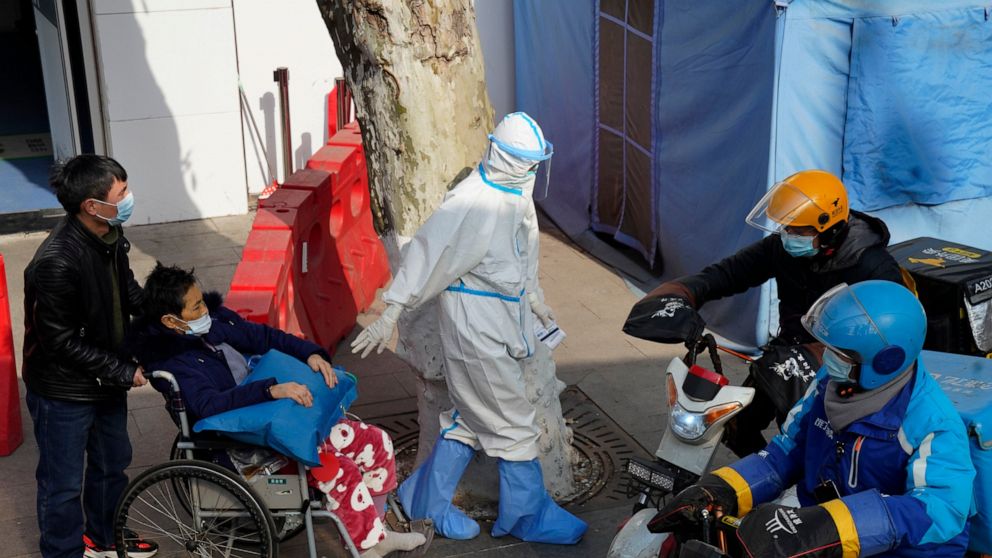BEIJING – A city in northern China is building a 3,000-unit quarantine facility to deal with an excessive flow of patients, as COVID-19 cases increase before the annual Lunar New Year rush.
State media on Friday showed teams leveling land, pouring concrete and setting up prefabricated rooms on farms in a peripheral part of Shijiazhuang, the capital of Hebei Province, which has seen most of the new cases.
This recalled scenes from the beginning of last year, when China quickly built field hospitals and turned gyms into isolation centers to deal with a spiral outbreak in Wuhan, where the virus was first detected in late 2019.
The peak in northern China comes as a team from the World Health Organization prepares to collect data on the origin of the pandemic in Wuhan, which lies to the south. The international team, most of whom arrived Thursday, must go through two weeks of quarantine before starting field visits.
Two of the 15 members were held in Singapore because of their health. One, a British national, was approved to travel on Friday after a negative coronavirus test, while the second, a Sudanese citizen of Qatar, again tested positive, said the Chinese Foreign Ministry.
China has largely contained the domestic spread of the virus, but the recent increase has caused concern due to its proximity to the capital, Beijing, and the imminent rush of people who plan to travel long distances to reunite their families for the traditional Lunar New Year more important.
The National Health Commission said Friday that 1,001 patients were in care for the disease, 26 in serious condition. According to the report, 144 new cases were registered in the last 24 hours. Hebei was responsible for 90 of the new cases, while Heilongjiang province, further north, registered 43.
Local broadcasts also took place in southern Guangxi and northern Shaanxi province, illustrating the virus’s ability to move across the vast country of 1.4 billion people despite quarantines, travel restrictions and electronic monitoring.
To date, China has reported 87,988 confirmed cases with 4,635 deaths.
Shijiazhuang was practically confined, along with the cities of Hebei, Xingtai and Langfang, parts of Beijing and other cities in the northeast. This cut travel routes, while more than 20 million people were told to stay home in the coming days.
China is moving ahead with vaccines using vaccines developed in China, with more than 9 million people already vaccinated and plans for 50 million to receive vaccines by the middle of next month.
About 4,000 doses are delivered daily at the Chaoyang Planning Art Museum, one of more than 240 locations in Beijing, where the first of the two doses was given on Friday to high-risk groups, including doctors, couriers and transport workers.
The vaccine, produced by a subsidiary of state-owned Sinopharm in Beijing, is the first to be approved for general use in China.
“Being vaccinated is not just to protect myself, but also to protect the people around me,” Ding Jianguang, a social worker who received her first injection earlier this month, told foreign journalists on a government-organized visit to the site.
Former World Health Organization official Keiji Fukuda, who is not part of the team in Wuhan, warned against expectations of any further progress in the visit, saying it could take years before any firm conclusions can be made about the origin of the virus.
“China will want to leave avoiding blame, perhaps changing the narrative. They want to look competent and transparent, ”he told the Associated Press in a Hong Kong video interview.
For its part, WHO wants to project the image that it is “assuming, exercising leadership, assuming and doing things in a timely manner”, he said.
Scientists suspect that the virus, which has killed more than 1.9 million people worldwide since the end of 2019, has leapt onto humans from bats or other animals, possibly in southwest China.
China approved the World Health Organization’s visit only after months of diplomatic disputes that generated an unusual public complaint by the WHO chief.
The delay, coupled with the Communist Party’s tight control over informing and promoting theories that the pandemic started elsewhere, added to speculation that China is trying to avoid discoveries that destroy its self-proclaimed leader in the battle. against the virus.
In Wuhan, street life looked a little different from other Chinese cities where the virus was largely controlled. Seniors gathered to drink and dance in a riverfront park on Friday, and residents praised the government’s response to the crisis.
In other countries, “people go out arbitrarily, walk together and get together, so it’s especially easy for them to be infected,” said Xiang Nan. “I hope they can stay home and cut down on travel. … Don’t let the pandemic spread any further. “
———
Associated Press journalists Sam McNeil and Ng Han Guan in Wuhan, China, and video producer Olivia Zhang in Beijing contributed to this report.
